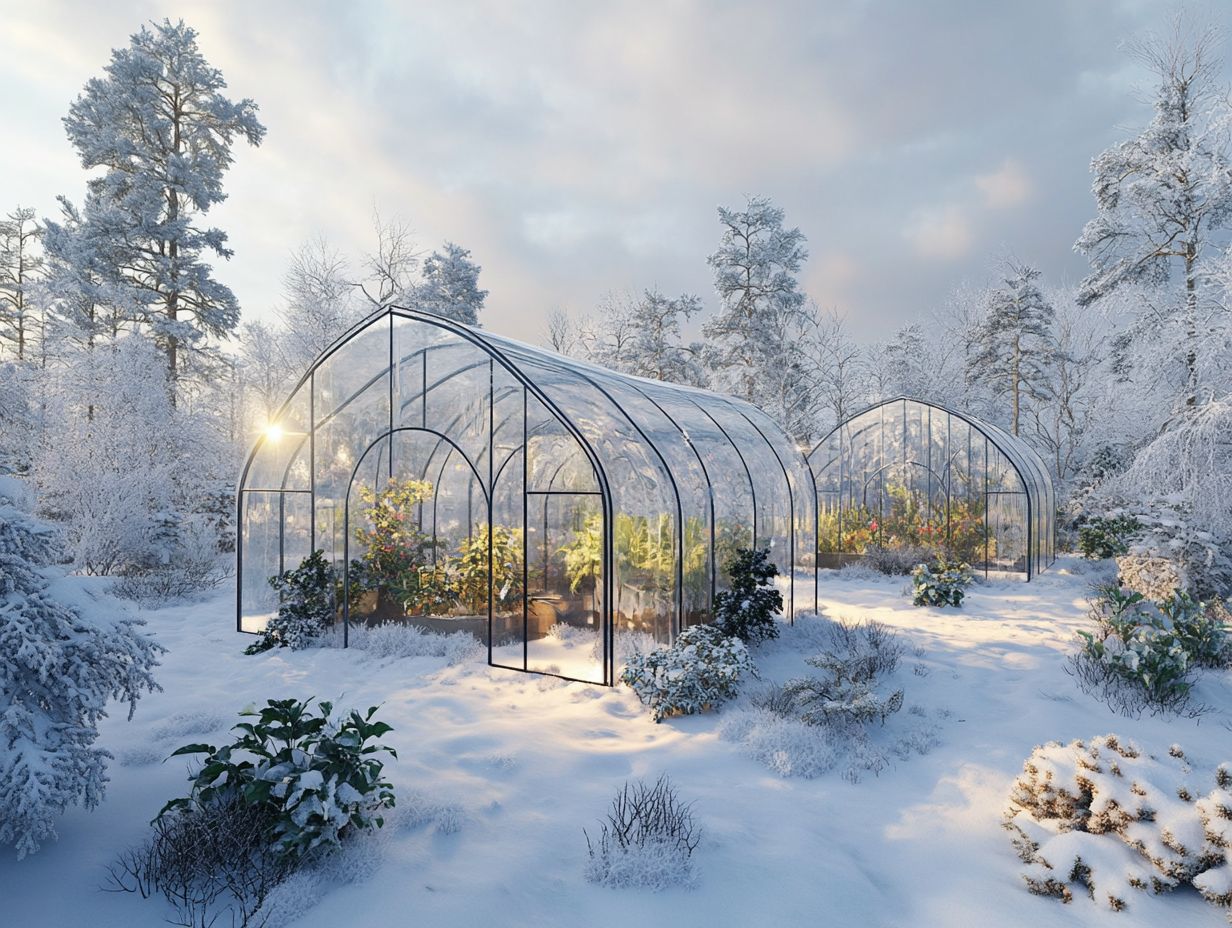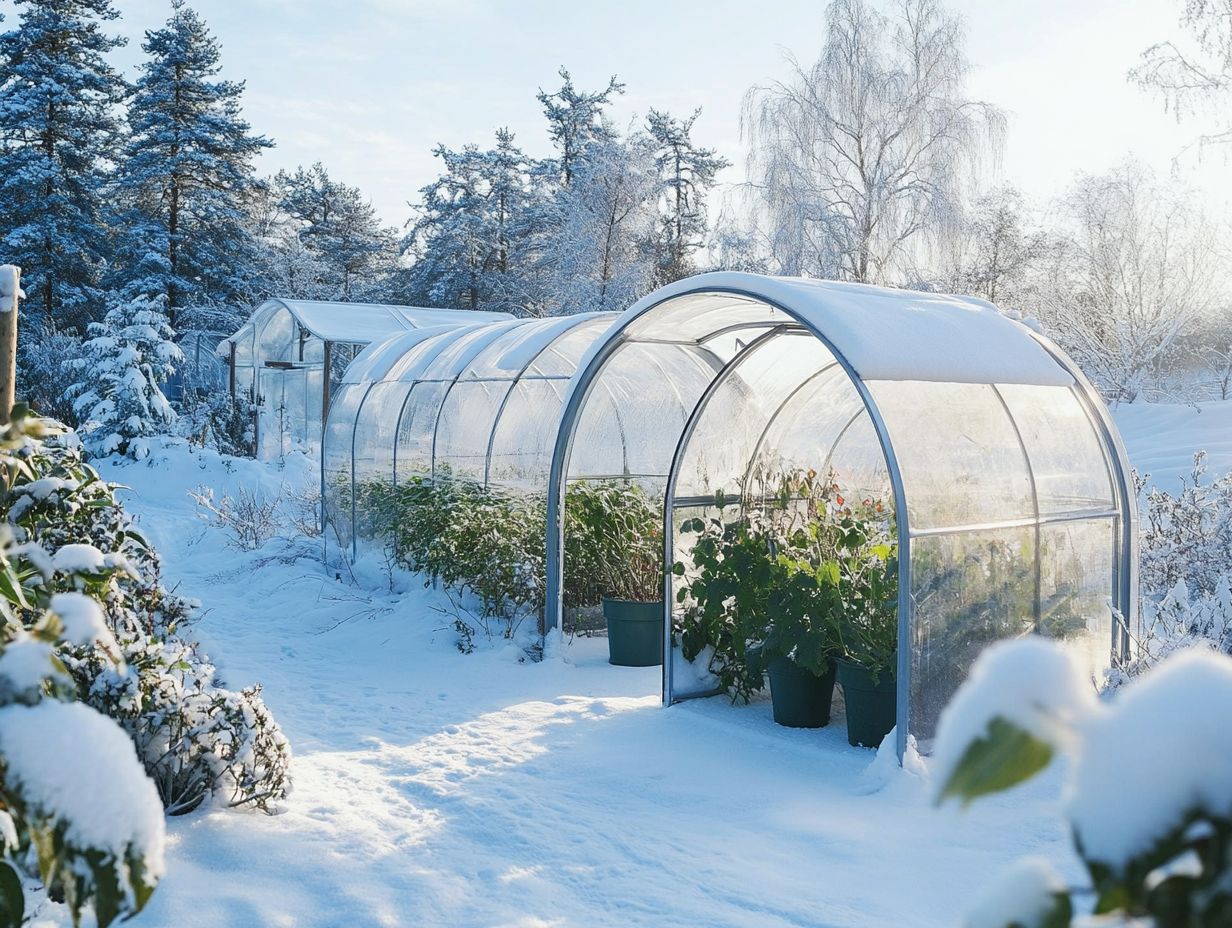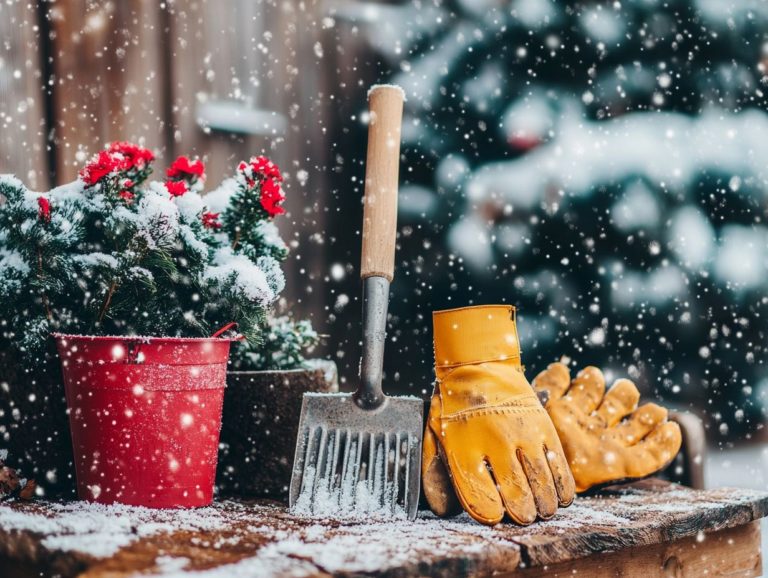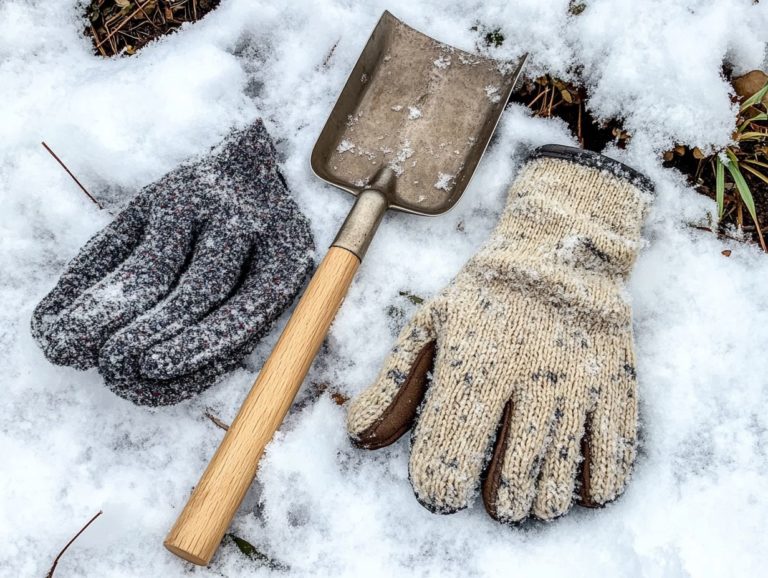Best Portable Greenhouses for Winter Gardening
As winter approaches, you may find yourself facing the challenge of maintaining your plants’ vitality amid the dropping temperatures.
Portable greenhouses present an elegant solution, enabling you to extend your gardening season while safeguarding delicate plants from frost’s harsh grasp.
This guide encompasses all the essential insights you need about these remarkable structures, from the various types and their benefits to practical advice on setup and maintenance.
Whether you re a seasoned gardener or just starting out, you will uncover how a portable greenhouse can elevate your winter gardening experience to new heights.
Contents
- Key Takeaways:
- 1. Types of Portable Greenhouses
- 2. Benefits of Using a Portable Greenhouse for Winter Gardening
- 3. Factors to Consider When Choosing a Portable Greenhouse
- 4. Top 5 Portable Greenhouses for Winter Gardening
- 5. How to Set Up a Portable Greenhouse for Winter Gardening
- 6. Maintenance Tips for Portable Greenhouses
- 7. Common Mistakes to Avoid When Using a Portable Greenhouse
- 8. How to Extend the Growing Season with a Portable Greenhouse
- 9. Creative Ways to Use a Portable Greenhouse in Winter
- 10. How to Choose the Right Plants for Winter Gardening in a Portable Greenhouse
- 11. How to Protect Your Plants from Frost in a Portable Greenhouse
- 12. Tips for Watering and Fertilizing Plants in a Portable Greenhouse
- 13. Common Pests and Diseases in Portable Greenhouses and How to Prevent Them
- 14. How to Properly Store and Clean Your Portable Greenhouse after Winter
- Frequently Asked Questions
- What are the benefits of using a portable greenhouse for winter gardening?
- What should I look for when choosing the best portable greenhouse for winter gardening?
- Can I use a portable greenhouse in extremely cold temperatures?
- Are there any maintenance tips for using a portable greenhouse in winter?
- Can I grow any type of plant in a portable greenhouse for winter gardening?
- Are there any additional accessories or tools that can enhance the use of a portable greenhouse for winter gardening?
Key Takeaways:

- Portable greenhouses provide a convenient and cost-effective solution for winter gardening.
- When choosing a portable greenhouse, consider factors such as size, materials, and durability.
- Proper maintenance, protection from frost, and choosing the right plants are key to successful winter gardening in a portable greenhouse.
1. Types of Portable Greenhouses
Portable greenhouses come in a variety of types, each tailored to meet your specific gardening needs and preferences. They provide the flexibility and convenience that every home gardening enthusiast desires.
Take pop-up greenhouses, for example. They’re incredibly simple to set up and perfect for those of you with limited space. These offer a temporary haven for starting seedlings or shielding your plants from unpredictable weather.
On the flip side, you have heavy-duty models, like those crafted by Gardman. These often boast durable polyethylene covers and sturdy aluminum frames, making them a reliable choice for long-term use across various climates.
If you’re feeling creative, DIY greenhouse kits present an exciting opportunity to customize the size and features to match your unique landscape. Just a heads-up: assembly can sometimes be a bit tricky.
Brands like Giantex provide budget-friendly options with straightforward assembly instructions, seamlessly blending functionality and accessibility.
Each type has its own set of pros and cons. While pop-ups may not be the most durable, heavy-duty versions can come with a heftier price tag. Understanding the materials involved, such as the heat-retaining properties of polyethylene and the resilience of aluminum, can greatly impact your choice.
2. Benefits of Using a Portable Greenhouse for Winter Gardening
Utilizing a portable greenhouse during your winter gardening can unlock a wealth of benefits. It allows you to create the perfect temperature for your plants and extend your growing season. For more insights, check out these tips for using greenhouses in winter gardening. This innovative structure acts as a shield, insulating your seedlings from harsh weather and ensuring they thrive even in the coldest months.
Portable greenhouses can adapt easily, helping with sustainable agriculture practices, reducing your dependence on chemical heating solutions and promoting eco-friendly gardening habits.
By maintaining a consistent microclimate, these greenhouses help you avoid temperature fluctuations that stress your plants, ultimately leading to healthier growth. You ll love how easy it is to enhance this effect by incorporating thermal mass, using items like water bottles or concrete blocks to better regulate temperatures within your greenhouse. Thermal mass refers to materials that can store heat, helping to maintain a stable temperature.
Incorporating native plants into your gardening approach not only boosts biodiversity but also fortifies the local ecosystem’s resilience. As trends increasingly lean toward environmentally conscious practices, embracing portable greenhouses benefits your gardening endeavors and aligns with broader sustainability goals in agriculture.
3. Factors to Consider When Choosing a Portable Greenhouse
When selecting a portable greenhouse, you need to consider several crucial factors to ensure it aligns with your gardening needs and thrives in your local climate.
From the materials that make up its structure to essential features like ventilation systems and weather resistance, each element plays a vital role in maintaining a healthy greenhouse environment. By evaluating the quality of the materials, you can gauge the longevity and durability of your investment in greenhouse kits.
Your choice between polycarbonate and PVC materials can significantly influence the structure s insulation properties and light transmission capabilities. These factors are critical for fostering plant growth. If you reside in a colder region, insulation might take precedence in your decision-making. Conversely, if you re in a sunnier climate, you may want to focus on adequate ventilation and light diffusion to prevent overheating.
The size of the greenhouse is also essential; it should fit comfortably in your space and accommodate plant growth. When purchasing greenhouse kits, look out for extra features like adjustable shelving and reinforced frames, which can enhance functionality tailored to your unique gardening requirements.
4. Top 5 Portable Greenhouses for Winter Gardening
Check out these five outstanding models that shine in features and durability for your winter gardening endeavors. They offer energy-efficient heating options and are excellent for seed starting, accommodating a variety of greenhouse accessories to create a thriving environment for your plants.
Whether you’re after a compact, portable design or a larger structure to maximize your yield, there s a model tailored to your needs.
With an array of sizes and materials available, these top picks provide flexibility for every gardener’s unique situation. For example, lightweight frames allow for easy relocation, while sturdier options are built to endure harsh winter conditions.
Many of these greenhouses come equipped with excellent ventilation systems and impressive heat retention capabilities, fostering healthy plant growth. Customer reviews rave about features like UV-resistant covers and adjustable shelving, which enhance usability and allow you to customize your setup.
Satisfaction ratings indicate that these greenhouses not only meet but often exceed expectations. Don t miss out on these top picks; they can transform your winter gardening!
5. How to Set Up a Portable Greenhouse for Winter Gardening

Setting up a portable greenhouse for winter gardening involves essential steps to create an effective environment for your plants. Begin by choosing a location that maximizes sunlight exposure while optimizing thermal mass, which refers to materials that store heat.
It s vital to integrate proper insulation and effective ventilation systems to maintain a comfortable temperature for your seedlings during the colder months. Selecting a level area free from wind barriers is crucial for stability. The ideal spot should soak up ample direct sunlight, which will warm the interior and encourage robust plant growth even in the darker periods of the year.
Next, think about the structural components, such as frame materials and covering types. Opting for sturdy materials can significantly enhance the durability of your greenhouse. Adding insulation through bubble wrap or thermal blankets will help retain precious heat. Strategically placed vents or fans can promote circulation, preventing any risk of overheating.
Incorporating water barrels or stones serves as a thermal mass, allowing you to capture and gradually release heat, creating a more consistent temperature for thriving plants. With these thoughtful steps, your winter gardening endeavors can flourish beautifully.
6. Maintenance Tips for Portable Greenhouses
Effective maintenance is crucial for ensuring the longevity and performance of your portable greenhouse. Regular inspections of the frame and covering materials can help identify potential issues like wear from weather exposure or damage. Cleaning your greenhouse regularly helps maintain optimal light transmission and prevents pests and diseases from affecting your plants.
The choice of materials significantly influences your maintenance needs. High-quality, weather-resistant components can withstand harsher climates, reducing the frequency of repairs. Routine tasks, like replacing worn or frayed covers, enhance your greenhouse’s durability. Seasonal cleanings keep surfaces free from debris and grime.
Proper ventilation and monitoring humidity levels contribute to a healthier growth environment. As the gardening season progresses, implementing these practices ensures that your greenhouse remains functional and efficient.
7. Common Mistakes to Avoid When Using a Portable Greenhouse
Many gardeners often stumble upon common mistakes that can impede their efforts in creating an ideal environment for plants. Understanding how to manage this versatile structure is essential.
A well-ventilated greenhouse promotes fresh air circulation, preventing excess moisture buildup that can lead to mold and mildew. Regularly check and adjust your ventilation panels or openings, especially during warmer months when temperatures can soar.
If you are starting seedlings, using lighting or heat mats is crucial for germination. Protecting delicate seedlings from sudden temperature fluctuations is important; utilizing row covers or screens can provide essential protection.
8. How to Extend the Growing Season with a Portable Greenhouse
A portable greenhouse is an exceptional tool for extending your growing season. It allows you to cultivate plants beyond their traditional growing periods. By using energy-efficient heating solutions and optimizing the environment, you can create ideal conditions for plant growth even in colder months.
To maximize effectiveness, add insulation like thermal blankets or bubble wrap to minimize heat loss during frigid nights. Regular monitoring of temperature and humidity levels is crucial, as fluctuations can negatively impact plant health. Use simple tools like thermometers and hygrometers to collect data for timely adjustments.
This proactive approach nurtures your plants and promises a harvest that will impress your friends!
9. Creative Ways to Use a Portable Greenhouse in Winter
Portable greenhouses can be your secret weapon in winter, transforming from gardening tools into innovative solutions for various challenges. For instance, learning how to use a greenhouse in winter gardening can enhance your gardening experience. Beyond winter gardening, these versatile structures can nurture seedlings, propagate flowers, or provide temporary shelters for delicate garden accessories.
Consider using the greenhouse for hydroponic systems, which allow plants to grow in water instead of soil, enabling you to enjoy fresh greens all year. The controlled environment also lets you experiment with exotic plant varieties that typically wouldn t thrive in colder climates.
You can even repurpose old shelving units within the greenhouse to craft vertical gardens, maximizing space while enhancing aesthetics. With clever lighting solutions and heating mechanisms, these setups can foster organic growth all winter, bridging the gap between seasonal constraints and your gardening passion.
10. How to Choose the Right Plants for Winter Gardening in a Portable Greenhouse

Choosing the right plants for your winter gardening adventure in a portable greenhouse is crucial for a successful experience. Not all plants can handle the chill, so you should opt for plants that can survive cold temperatures.
By focusing on effective seed-starting techniques, you can truly maximize your harvest, even during the winter months.
Consider factors like plant hardiness zones and your specific climate. These elements significantly influence which varieties will thrive. For instance, cold-tolerant plants, such as kale, spinach, and certain herbs, can really shine in this controlled environment.
Also, keep compatibility in mind. Some plants actually help each other grow a practice known as growing different plants together to help each other grow.
When starting seeds, ensure you use seed trays with proper drainage. Adequate light is key during those shorter winter days to help those young plants flourish. Additionally, maintaining optimal humidity levels is crucial for preventing mold and promoting healthy growth. Regular monitoring becomes vital during the winter months.
11. How to Protect Your Plants from Frost in a Portable Greenhouse
Protecting your plants from frost is key to maximizing your portable greenhouse, especially during chilly months when temperatures can drop dramatically.
By implementing proper insulation and adding thermal mass elements, you can create a stable environment that reduces frost risk and encourages robust plant growth. This smart strategy safeguards your plants and helps them thrive!
To maintain optimal conditions, regularly monitor temperature and humidity levels. Fluctuations can stress your plants. Consider using frost blankets or bubble wrap on the interior surfaces for extra insulation.
Integrating materials like water-filled barrels or stone slabs can also help retain warmth, gradually releasing it when temperatures dip. These techniques do more than just protect your plants; they cultivate an environment where growth can flourish, even in the face of frost challenges.
12. Tips for Watering and Fertilizing Plants in a Portable Greenhouse
Proper watering and fertilizing practices are absolutely essential for keeping your plants thriving in a portable greenhouse. The controlled environment can significantly alter your usual gardening routines.
By understanding the unique needs of your plants and adjusting your watering schedule, you can prevent the pitfalls of over or under-watering, both of which can hinder growth. Timely fertilization is equally vital, as it supports nutrient uptake and ensures your seedlings remain in optimal health.
Consider the factors at play within your greenhouse humidity, temperature, and light levels all influence how much water and nutrients your plants require. Some varieties may flourish with frequent, lighter watering, while others might prefer deeper, less frequent applications.
Utilizing a combination of drip irrigation or soaker hoses can deliver consistent moisture without the risk of waterlogging the soil. Applying a balanced fertilizer during the growing season is crucial for providing your plants with essential nutrients.
Just remember to adjust the type and frequency based on each plant’s specific demands, enhancing their overall vitality and productivity.
13. Common Pests and Diseases in Portable Greenhouses and How to Prevent Them
Managing common pests and diseases in your portable greenhouse is essential for maintaining the health and productivity of your plants. Without proper intervention, these issues can escalate rapidly. Regular inspections and maintenance of your greenhouse environment are crucial to preventing infestations and diseases from taking root.
By employing effective plant protection strategies, including organic pest control methods, you can safeguard your plants and cultivate a flourishing indoor garden.
Routine checks are essential. Monitoring humidity and temperature can help prevent pests like aphids and spider mites.
Use pest management techniques. They combine beneficial insects and practices like crop rotation and cleaning regularly.
Regularly cleaning your tools is important! Keep them squeaky clean to help reduce diseases in your greenhouse. Organic solutions, like neem oil or insecticidal soaps, can effectively combat various pests while preserving the integrity of your environment. Consistency in these practices not only fosters a healthy greenhouse atmosphere but also promotes robust plant growth.
14. How to Properly Store and Clean Your Portable Greenhouse after Winter
Properly storing and cleaning your portable greenhouse after winter is essential for ensuring its longevity and readiness for the next growing season. Begin by giving the structure a thorough cleaning to eliminate any dirt, pests, and debris that may have accumulated during your winter gardening adventures. Protecting materials from the elements can significantly extend their lifespan.
- Start the cleaning process by disassembling any removable components like shelves and racks. Wash them with warm, soapy water. Inspect each part for signs of wear or damage, and make necessary repairs before putting everything away. This is especially important for those investing in greenhouse kits or a DIY greenhouse.
- Gently scrub the frame and cover with a soft-bristle brush. This will help restore clarity and prevent mildew buildup. Once the portable greenhouse is spotless, dry all the components thoroughly to prevent moisture from sneaking in.
- When it s time to store your greenhouse, select a dry and sheltered location to minimize exposure to harsh elements. Covering it with a tarp or breathable fabric will help protect it from dust and harmful UV rays, which is especially important for heavy-duty greenhouse structures.
Engaging in regular seasonal maintenance like checking for pests and making minor repairs will keep your greenhouse structure in top condition and ready for planting when the time comes. By caring for the structure properly, you not only enhance its durability but also create a thriving environment for your home gardening endeavors.
Frequently Asked Questions

What are the benefits of using a portable greenhouse for winter gardening?
A portable greenhouse helps you grow plants year-round and protects them from cold weather. It allows you to easily move plants for optimal sunlight and temperature control.
What should I look for when choosing the best portable greenhouse for winter gardening?
When choosing the best greenhouse for winter gardening, consider its size, material, insulation abilities, and additional features like shelves or ventilation systems.
Can I use a portable greenhouse in extremely cold temperatures?
Yes, there are portable greenhouses specifically designed for extremely cold temperatures. Look for features such as double-walled panels and insulated frames for maximum insulation and protection against freezing temperatures.
Are there any maintenance tips for using a portable greenhouse in winter?
To ensure the best performance from your portable greenhouse in winter, regularly check for snow buildup on the roof. Also, provide ventilation to prevent overheating and monitor soil moisture to avoid drying out.
Can I grow any type of plant in a portable greenhouse for winter gardening?
You can grow many types of plants in a portable greenhouse. However, some plants need specific temperatures, so make sure to research your plants’ needs for the best results before planting.
Are there any additional accessories or tools that can enhance the use of a portable greenhouse for winter gardening?
Yes, various accessories can enhance your portable greenhouse experience in winter gardening. Consider using energy-efficient heating mats, grow lights, and monitors for temperature and humidity.






